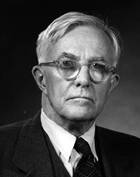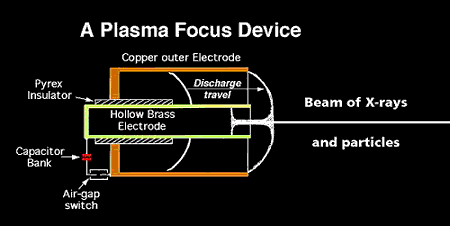Nowhere is the gravitational paradigm of cosmology shown to exhibit more strangeness than in compact high energy phenomena in deep space. A report in the journal Nature of 15 November proposes that a recently discovered star “is made of an exotic stuff called ‘strange matter’, never yet seen on Earth”. In other words, it may be a “strange star”. This bizarre suggestion comes out of the mathematics describing stars that generate rapid pulses of radiation, commonly called “pulsars”. The x-ray pulses are thought to be due to a rotating beam of x-rays that flashes toward the Earth once per revolution like a cosmic lighthouse.
Report from Nature [Link dead 2012]

Picture credit: W. Feimer (Allied Signal), GSFC, NASA
This seemingly simple model began to show signs of strain many years ago when the first millisecond pulsar was discovered. In order to flash (rotate) several times a second a pulsar would need to be very compact indeed, only a few kilometres in diameter. But to generate x-rays gravitationally requires an extreme concentration of matter to accelerate particles to a sufficiently high energy so that when they strike the star x-rays are produced. The only objects that theoretically meet that requirement are neutron stars and black holes. Both kinds of object are well outside our experience.
The discovery now of an x-ray pulsar SAX J1808.4-3658 (J1808 for short), located in the constellation of Sagittarius, that flashes every 2.5 thousandths of a second (that is 24,000 RPM!) goes way beyond the red-line even for a neutron star. So another ad hoc requirement is added to the already long list – this pulsar must be composed of something even more dense than packed neutrons – strange matter!
When astrophysicists are having difficulty with their models they traditionally turn for rescue to the nuclear physicists. (They were called in to explain away the missing solar neutrinos). The news report goes on: “The most fundamental building blocks of nuclear matter are thought to be particles called quarks. The ‘regular’ nuclear particles or ‘nucleons’ – protons and neutrons – are composed of ‘up’ and ‘down’ quarks: two up quarks and a down quark make one proton, while a neutron consists of two downs and an up. But there are at least four other, more exotic, kinds of quark, amongst them the so-called ‘strange’ quark. In nucleons, quarks are supposed to exist in inseparable groups of three, which is why no one has ever seen an isolated quark. But at extremely high densities of matter, quarks may become uncoupled or ‘deconfined’. ‘Strange matter’ is a melange of deconfined up, down and strange quarks. Physicists are hoping that the new particle colliders currently under construction, such as the Large Hadron Collider at CERN in Geneva, will create conditions extreme enough to break quarks free. But the Universe may have got there first. X.-D. Li of Nanjing University, China, and colleagues’ suggestion that J1808 is a strange star follows a small number of similar proposals for other astrophysical objects that emit bursts of X-rays. The X-ray bursts from these objects are signs of violent activity of a sort that becomes possible only when matter is pushed to extremes.”
I think J R Saul highlighted the language problem we are seeing here when he wrote:
“Ten geographers who think the world is flat will tend to reinforce each other’s errors. If they have a private dialect in which to do this, it becomes impossible for outsiders to disagree with them. Only a sailor can set them straight. The last person they want to meet is someone who, freed from the constraints of expertise, has sailed around the world.” J R Saul, Voltaire’s Bastards.
The Nobel Laureate, Irving Langmuir, coined the term “pathological science” for “the science of things that aren’t so”.
Two key symptoms of such science are:
(1) the resort to fantastic theories contrary to our experience, and
(2) the use of ad-hoc requirements to save the appearances.

Irving Langmuir
If we apply these criteria, two disciplines that share line honours for pathological or strange science are cosmology and particle physics. They both deal with unseen objects – neutron stars, black holes, quarks, etc. They both produce fantastic ad-hoc requirements to explain new discoveries – dark matter, super-heavy objects and exotic particles. They cross-infect each other with their theoretical requirements both to save appearances and convince governments to spend large sums of research money for super-colliders to replay bits of a hypothetical Big Bang, or to build gravity-wave telescopes when we have no proof such waves exist. The above report brings such strange science sharply into focus.
It is not ordinary matter, but scientific models that are being pushed to extremes. Einstein warned: “Most mistakes in philosophy and logic occur because the human mind is apt to take the symbol for reality”. Neutron stars and quarks have never been seen. They are derived from mathematical symbols. Let’s take quarks first. There is little to suggest that any of the shrapnel from high energy colliders exists in normal matter. If enormous energy is spent in shattering a proton to unlock the hypothetical quarks then the energy itself may manifest as particles that don’t play any part in ordinary matter. Flying a 747 into a mountainside and picking over the ruins is not the best way of finding out how an aircraft works. Suggesting that a star can be composed stably of unobserved particles simply because a theory of invisible, super-heavy objects demands it is asking too much!
Here are some of the many unstated assumptions underpinning the X-ray pulsar model:
(my comments are in italics)
1. It is assumed that the physics of neutral matter and ideal gases on Earth can be used to explain the operation of the glowing balls of plasma we call stars.
99.999% of the universe is made of plasma. It is not necessarily electrically neutral and does not behave like an ideal gas.
2. It is assumed that all interstellar plasma is mostly an ionized, uncharged, superconducting gas that can trap and carry magnetic fields.
Plasma is not a superconductor so magnetic fields cannot be trapped in it. The origin of the magnetic fields is not clear from standard theory. The ELECTRIC UNIVERSE® proposes that magnetic fields and plasma filaments in space are formed by electrical currents in charged plasma. (No book on astronomy mentions electrical effects).
3. It is assumed that we understand how our Sun and other stars shine, evolve, and someday die or form neutron stars.
We do not understand the Sun’s magnetic field, the hot corona, solar wind, solar cycle, x-ray variability, coronal mass ejections, sunspots, low neutrino count, etc., etc.
4. It is assumed that we understand what causes a supernova explosion.
The number of ad hoc assumptions required for a mechanical explosion following a sudden stellar implosion results in a highly unlikely explanation. SN1987A showed that such explosions are not spherically symmetrical.
5. It is assumed that a supernova can “squeeze” stellar protons and electrons together to form neutrons.
A first-order wild conjecture. The model incorporates many unproven assumptions about the unseen internal structure of stars. If the implosion is not spherically symmetrical there may be insufficient “squeeze” to force protons and electrons to merge, even if that were possible. No account is taken of electrical effects. Our own Sun with a mean density only slightly above that of pure hydrogen shows that electrostatic forces are at work within stars to offset compression forces.
6. It is assumed that it is possible to form a stable neutron star.
When not associated with protons in a nucleus, neutrons decay into protons and electrons in a few minutes. Atomic nuclei with too many neutrons are unstable. If it were possible to form a neutron star, why should it be stable?
7. It is assumed that a supernova can further squeeze neutrons until they “pop their quarks”.
A second-order wild conjecture.
8. It is assumed that it is possible to have a stable massive object composed of quarks.
A third-order wild conjecture based on the pathologies of both astrophysics and nuclear physics. It is an unseen object composed of unseen matter.
9. It is assumed that a neutron star can convert the energy of infalling matter into tightly collimated, pulsed x-ray beams.
It is difficult to imagine a more unlikely way of achieving this effect.
10. It is assumed that a spinning object is required to cause the pulsations.
Only required in a purely mechanical model.
11. It is assumed that Nature overlooks the normal (and infinitely easier) method of creating x-rays by accelerating electrons in an electric field.
12. It is assumed that Nature overlooks the simplest way of creating pulsed radiation by a charge-discharge relaxation oscillator cycle (where electric charge builds up slowly until a threshold is reached and a sudden discharge occurs).
13. It is assumed that Nature ignores the simplest way of creating a highly collimated x-ray beam and particle jet (if one is required from the observations) by the use of the plasma focus effect.
Is this science or science-fiction?
The ELECTRIC UNIVERSE® model assumes that Nature knows best. It does not require strange matter or a strange star. The x-ray pulses are caused by regular electric discharges between two or more orbiting, normally constituted, electrically charged bodies. It is a manifestation of a periodic arc instead of a spinning star. If beaming of the radiation is occurring then that should be verifiable here on Earth in the lab by studying the plasma focus device.

The ELECTRIC UNIVERSE® model lets go of the Newtonian dogma that gravity is the driving force in the cosmos. It allows for the possibility that the fundamental characteristic of normal matter – its electric charge – plays the most significant role. So if gravity wave telescopes detect anything at all, it won’t be gravity waves from super-heavy objects. And particle physicists who are trying to work out how the universe was constructed from strange matter early in the Big Bang are wasting their time. The astronomer Halton Arp, author of the Atlas of Peculiar Galaxies, has conclusively disproven the theory of an expanding universe and so knocked out the foundation of the Big Bang theory.
Meanwhile the plasma physicists and electrical engineers are waiting in the wings for those astro-and nuclear-physicists parading their strange science in public to get off the stage. It would be entertaining if it weren’t so serious. But it is costing us dearly and holding up real progress.


